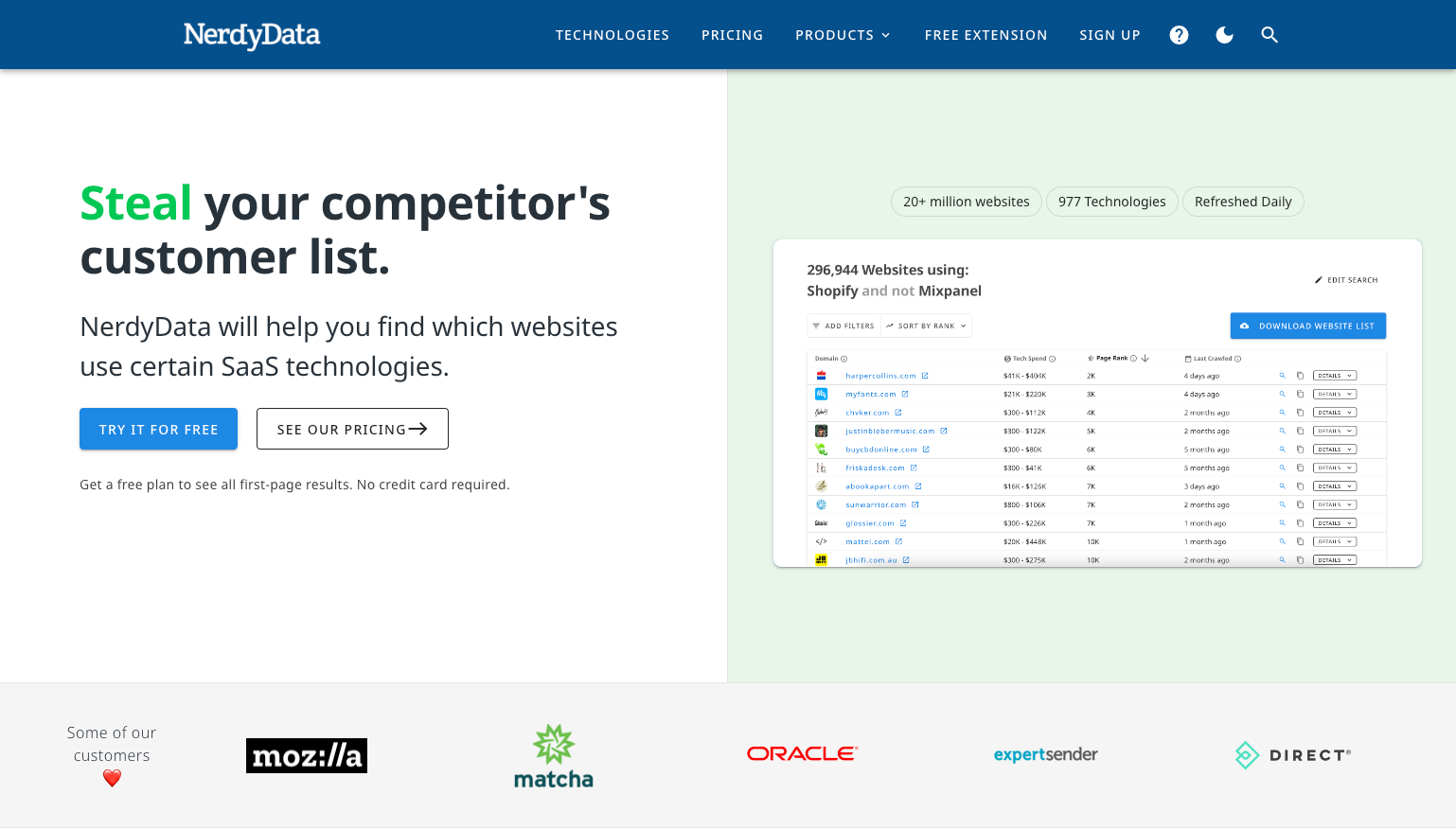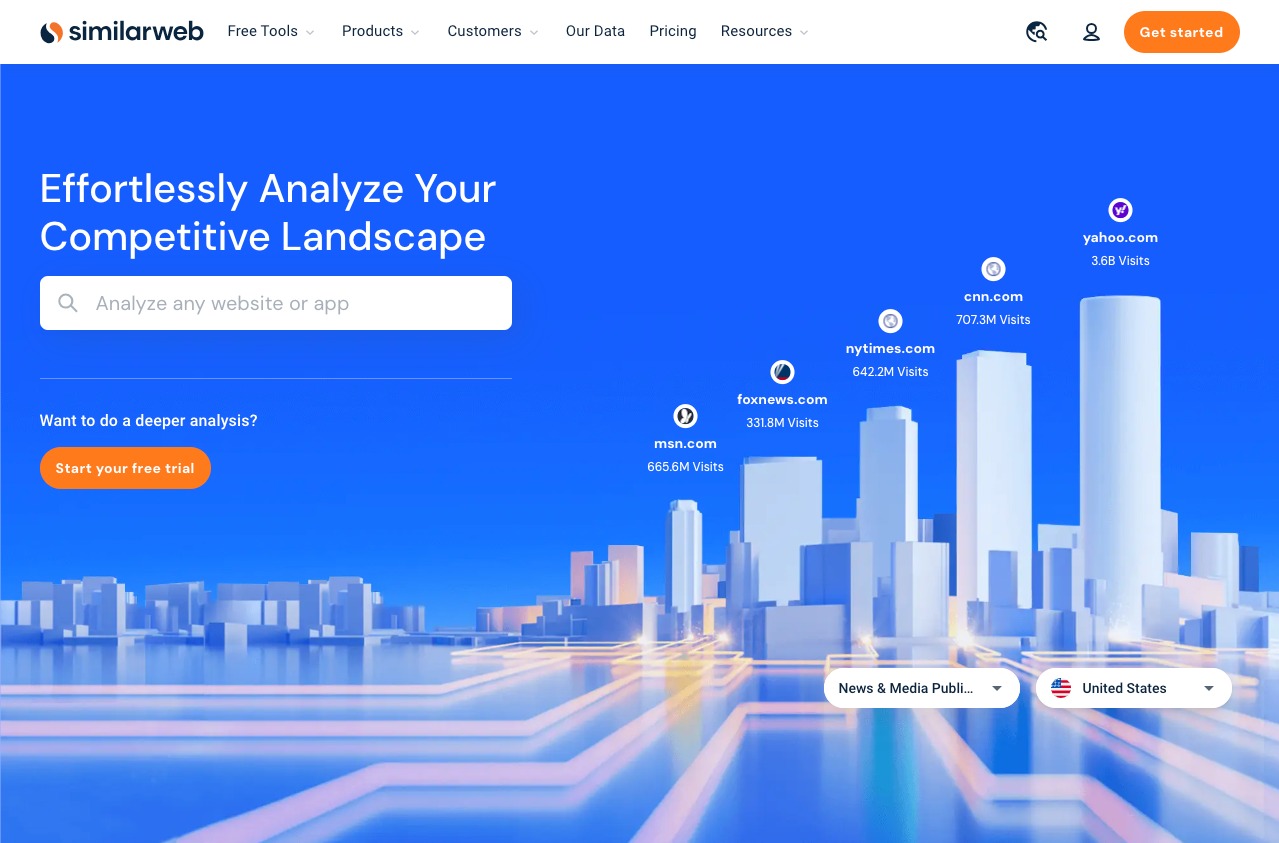5 Free Online Market Research and Competitor Research Tools
In the pulsating rhythm of the Industry 4.0 era, where data reigns supreme and strategic decisions pivot on insights gleaned from the digital realm, businesses are constantly in pursuit of the next edge that propels them ahead in their markets. For marketers, understanding the dynamics of the market and staying a step ahead of competitors is paramount. In this quest for knowledge, leveraging free online services becomes not just an option but a strategic imperative.
Today’s digital landscape offers a plethora of tools and resources to delve into market research and competitive analysis without draining your budget. These tools equip businesses with the power to decipher trends, scrutinize competitors, and steer marketing strategies with a precision that was once the privilege of those with hefty budgets. In this article, we unveil five such free online services tailored to empower business owners and marketers in deciphering market segments and making informed decisions in the cutthroat world of commerce.
1. Google Trends
Google Trends is a versatile and powerful tool offering real-time insights into search queries, aiding businesses in tracking trends, identifying seasonal fluctuations, and conducting comparative analysis. Its ability to provide geographical data and aid in content ideation makes it a valuable asset for marketers. However, limitations include its limited historical data, potential lack of data precision, and the need for additional context behind observed trends. Despite these limitations, Google Trends remains an essential resource for businesses to stay abreast of market interests and make informed decisions in their marketing strategies.
Advantages of Google Trends:
- Real-time Insights: Google Trends provides real-time data on search queries, allowing users to track the popularity and trends of specific keywords or topics. This up-to-date information enables businesses to stay current with market interests and preferences.
- Identifying Seasonal Trends: It helps in identifying seasonal fluctuations and trends, which is invaluable for businesses in adjusting marketing campaigns and strategies according to changing consumer behaviors throughout the year.
- Comparative Analysis: Users can compare the popularity of multiple search terms or topics. This comparative analysis aids in understanding which keywords or topics are more relevant or gaining traction in a specific market, assisting in strategic decision-making.
- Geographical Insights: The tool offers geographical data, showcasing where search terms are most popular. This feature is beneficial for businesses targeting specific regions or countries, allowing them to tailor their marketing efforts geographically.
- Content Ideation: It can be utilized for content ideation by identifying trending topics. This helps marketers create content that aligns with current interests and drives traffic to their websites or platforms.
Disadvantages of Google Trends:
- Limited Historical Data: Google Trends provides data from 2004 onwards, but the historical data might not cover certain long-term trends or fluctuations that occurred before this timeframe, limiting comprehensive analysis.
- Limited Data Precision: While it offers insights based on search queries, it may not fully represent consumer behavior or actual market trends, as it relies solely on Google’s search data and algorithms, excluding other sources of information.
- Lack of Detailed Context: The tool may lack detailed context behind the trends, requiring additional research to understand the reasons or factors driving the observed trends, which might not be readily available within the platform.
- Inability to Provide Exact Numbers: Google Trends uses a relative scale to showcase the popularity of search terms rather than providing exact numerical data. This can sometimes lead to challenges in accurately measuring the actual volume or quantity of searches.
- Limited Customization: While it offers a variety of filters and parameters, the tool might have limitations in terms of customization for specific niche industries or highly specialized topics, potentially limiting its applicability in certain cases.
Understanding these advantages and disadvantages can help businesses harness the power of Google Trends effectively while being aware of its limitations in conducting market research and competitor analysis.
2. Nerdydata
NerdyData offers a unique perspective by diving into website source code and providing valuable insights into technological trends, competitive analysis, and SEO strategies. However, its complex interface, limited free features, dependence on web crawling, lack of contextual insights, and potential privacy concerns are factors to consider while utilizing this tool for comprehensive competitor analysis and technological research.
Advantages of NerdyData:
- Deep Website Search: NerdyData specializes in deep website search, allowing users to explore and analyze source code across the web. This capability enables businesses to gain insights into competitors’ website structures, technologies used, and coding practices.
- Technology Profiling: It provides detailed information about the technologies, scripts, frameworks, and plugins utilized by websites. This data is invaluable for understanding industry trends, technological preferences, and competitor analysis.
- Keyword and Code Analysis: Users can conduct keyword searches within source code, helping discover how competitors implement SEO strategies, use specific keywords, or structure their web content for better search engine visibility.
- Identifying Trends and Innovations: NerdyData enables users to spot emerging trends and innovations within industries by examining the technologies and code implementations adopted by leading websites, providing a glimpse into upcoming industry shifts.
- Competitive Edge: By comprehensively analyzing competitors’ website code and technology stack, businesses gain a competitive edge, allowing them to adapt their strategies, technologies, and online presence more effectively.
Disadvantages of NerdyData:
- Complex Interface: The platform’s interface might appear complex for beginners or users unfamiliar with coding or web development, potentially limiting its accessibility and ease of use for a broader audience.
- Limited Free Features: While NerdyData offers free access, certain advanced features and in-depth analyses might require a paid subscription, restricting full access to all its functionalities for users operating solely on the free tier.
- Dependence on Website Crawling: The accuracy and comprehensiveness of the data provided heavily rely on the platform’s web crawling capabilities. Limitations in website coverage or outdated information could affect the accuracy of insights.
- Lack of Contextual Insights: The tool primarily focuses on technical aspects and may lack contextual insights into the strategies or reasoning behind the code implementations, requiring additional research for a comprehensive understanding.
- Privacy Concerns: As it delves deep into website code, there might be privacy concerns related to the access and analysis of proprietary or sensitive information within the source code of websites.
3. SimilarWeb
SimilarWeb is a robust platform providing comprehensive insights into competitor performance, audience behavior, and market trends. However, its limitations in data accuracy, access to detailed information, dependency on estimations, and restricted historical data should be considered while leveraging this tool for competitor analysis and market research.
Advantages of SimilarWeb:
- Comprehensive Website Analysis: SimilarWeb provides comprehensive insights into website traffic, engagement metrics, audience demographics, and referring sources. This information helps in understanding competitor performance and market positioning.
- Benchmarking Competitor Performance: Users can compare their website’s performance against competitors, benchmarking traffic metrics, keyword rankings, and audience engagement. This comparison aids in identifying strengths and areas for improvement.
- Audience Behavior Analysis: The tool offers detailed audience behavior analysis, including browsing patterns, time spent on site, and popular pages. This data assists in tailoring marketing strategies to better resonate with the target audience.
- Keyword and Search Analysis: SimilarWeb provides data on organic and paid keywords driving traffic to websites. This information is crucial for optimizing SEO strategies and understanding competitor keyword strategies.
- Industry and Market Trends: It offers insights into industry trends, emerging markets, and popular websites within specific niches. This information aids businesses in staying abreast of market shifts and identifying potential opportunities.
Disadvantages of SimilarWeb:
- Data Accuracy Limitations: While SimilarWeb provides valuable estimates, the accuracy of its data might vary, especially for smaller websites or in regions with less online traffic, potentially leading to inaccuracies in analytics.
- Limited Access to Detailed Information: Some advanced features and granular data insights are only available through paid subscriptions, restricting access to comprehensive analytics for users relying solely on the free version.
- Inability to Access Internal Metrics: SimilarWeb mainly focuses on external data, lacking access to internal metrics such as conversion rates, sales data, or specific user actions on the website, limiting a holistic view of performance.
- Limited Historical Data: The tool’s historical data might be limited, which could hinder the ability to analyze long-term trends or seasonal fluctuations accurately.
- Dependency on Algorithmic Estimations: SimilarWeb utilizes algorithms to estimate data for websites, and these estimations might not always precisely reflect actual metrics, potentially impacting the reliability of insights.
4. Datanyze
Datanyze is a powerful tool for technological profiling and lead generation, offering comprehensive insights into competitor technologies. However, it’s higher pricing, limited company coverage, dependency on web crawling, complexity for novice users, and focus on technology over contextual insights are considerations for businesses when utilizing this tool for competitive analysis and lead generation.
Advantages of Datanyze:
- Technological Profiling: Datanyze specializes in technological profiling, offering insights into the technologies and tools used by companies across the web. This information is valuable for understanding market trends, technological preferences, and competitor analysis.
- Lead Generation: The platform assists in lead generation by identifying potential prospects based on the technologies they use. This feature enables businesses to target specific companies that align with their services or products.
- Alerts and Notifications: Datanyze offers customizable alerts and notifications for changes in a company’s technology stack. This helps in staying updated on competitors’ technological adaptations or shifts.
- Integration and Data Export: It allows integration with various CRM and sales tools, facilitating seamless data transfer for sales and marketing teams. Data export options provide flexibility in utilizing acquired information across multiple platforms.
- Comprehensive Data Visualization: Datanyze presents data through user-friendly visualizations, making it easier for users to interpret and analyze complex technological information effectively.
Disadvantages of Datanyze:
- Costly Pricing Structure: Datanyze’s advanced features and in-depth analysis often come with a higher price tag, making it less accessible for smaller businesses or those operating on limited budgets.
- Limited Company Coverage: The platform’s database might not encompass a comprehensive list of companies, especially smaller or less well-known businesses, potentially limiting the scope of analysis for certain industries.
- Dependency on Web Crawling: Data accuracy and completeness are subject to the platform’s web crawling capabilities. Limitations in web crawling could result in incomplete or outdated information.
- Complexity for Novice Users: The tool’s complexity might pose challenges for users unfamiliar with technological jargon or those with limited experience in data analysis or technological profiling.
- Focus on Technology, Less on Context: Datanyze primarily focuses on technological aspects of companies, potentially lacking contextual insights or reasons behind the technology choices, necessitating additional research for a comprehensive understanding.
NetMarketShare offers valuable insights into market share trends for operating systems, browsers, and devices, aiding businesses in strategic decision-making and adapting their approaches. However, considerations about its limited coverage and sample size, dependency on data sources, delayed updates, lack of detailed methodology disclosure, and limited industry-specific data should be taken into account when utilizing this tool for market analysis and decision-making.
Advantages of NetMarketShare:
- Detailed Market Share Data: NetMarketShare provides comprehensive data on market share trends for operating systems, browsers, and devices. This information is crucial for businesses to understand the prevalent technology landscape and consumer preferences.
- Historical Trends Analysis: The platform offers historical data, allowing users to analyze long-term trends and fluctuations in market shares. This helps in identifying patterns and making informed predictions about future market directions.
- Geographical Insights: NetMarketShare presents data on market shares across various regions and countries, enabling businesses to tailor their strategies according to regional preferences and trends.
- Platform and Browser Analytics: It offers insights into the performance of different platforms and browsers, aiding in website optimization, compatibility testing, and targeted marketing strategies.
- In-Depth Reports and Analysis: NetMarketShare generates detailed reports and analyses based on market share data, providing actionable insights for businesses to adapt their strategies and stay competitive in the market.
Disadvantages of NetMarketShare:
- Limited Coverage and Sample Size: The data might be limited in scope and sample size, potentially not representing the entire market accurately, especially for newer or niche technologies.
- Dependency on Data Sources: The accuracy and reliability of the data rely on the sources used by NetMarketShare, which might lead to discrepancies or biases in the reported market share.
- Delayed Data Updates: Updates to market share data might not be in real-time, leading to a delay in reflecting current market dynamics and potentially impacting the timeliness of decision-making.
- Lack of Detailed Methodology: NetMarketShare doesn’t always disclose the detailed methodology behind data collection and analysis, making it challenging to evaluate the accuracy and reliability of the reported market shares.
- Limited Industry-specific Data: The platform might lack industry-specific data, limiting its usefulness for businesses operating in highly specialized or niche markets.
Conclusion
In the ever-evolving landscape of Industry 4.0, where every click, view, and trend holds the potential to shape market dynamics, these five free online services emerge as unsung heroes for business owners and marketers. From the ubiquitous reach of Google Trends to the intricate data mining capabilities of NerdyData and the comprehensive insights offered by SimilarWeb and Datanyze, each tool opens a door to a treasure trove of information vital for understanding market trends and competitor strategies.
Net Market Share stands tall as a beacon illuminating the intricate web of market share dynamics, offering a panoramic view of the digital market landscape. As we navigate through the myriad bytes of information available online, these tools serve as the guiding compass, allowing businesses not only to survive but thrive amidst fierce competition.
Embracing these free online services empowers businesses, irrespective of their size or budget, to steer their ships amidst the turbulent waters of the digital market. With strategic insights at their fingertips, entrepreneurs and marketers are better equipped to make informed decisions, tailor their strategies, and ultimately emerge victorious in their respective market segments. As we continue to traverse this digital revolution, these tools remain indispensable companions, guiding us toward success in the ever-evolving landscape of Industry 4.0.













